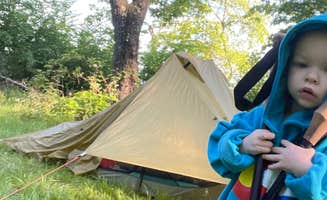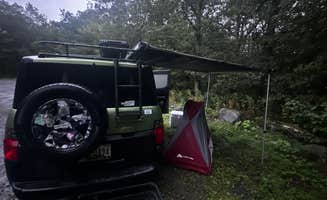Dispersed camping near Summit Hill, Pennsylvania offers access to the northeastern section of the Appalachian Trail corridor where elevation ranges between 900-1,500 feet. This region experiences distinct seasonal changes with fall foliage peaking in mid-October and winter snow often making primitive sites inaccessible without proper gear. Campers should note that most locations require carrying in all water and supplies.
What to do
Wildlife observation: Thunder Swamp Trailhead connects to extensive hiking trails through Pennsylvania game lands. "Trailhead parking was chill for a night. No trouble. Tons of hiking. Went down Saw Creek trail to a marsh," reports camper Jason R. who used the site as a basecamp for marsh exploration.
Rock scrambling: The Blue Mountain ridge contains multiple boulder fields and rock formations. "The hike to the overlook is really lovely; short and rocky," notes Dani T. about the trail access from Bake Oven Knob, which serves as both an overnight parking area and trailhead for day hiking.
Night sky viewing: Clear nights provide opportunities for stargazing away from city lights, particularly at higher elevation sites. The ridge areas offer unobstructed views during new moon phases when skies are darkest.
What campers like
Hammock camping options: Multiple sites along the trail corridor feature suitable trees for hammock setups. "Good trees for hammocking," confirms Katharine T. at Appalachian Trail- Designated Backpacker Campsite 2, noting the site offers "plenty of space" with more secluded spots available for those seeking privacy.
Overnight vehicle access: Some free camping near Summit Hill, Pennsylvania includes parking areas where overnight stays in vehicles are permitted. "I've overnighted in my van here a bunch, no problems," reports one visitor about Bake Oven Knob, which features two large parking lots suitable for vehicle camping.
Bear protection infrastructure: Safety measures for food storage exist at certain designated sites. "Well maintained w bear boxes provided," notes a reviewer about Appalachian Trail- Designated Backpacker Campsite 2, helping address wildlife concerns in an area with known black bear activity.
What you should know
Water planning essential: Sources for drinking water are limited or nonexistent at most dispersed camping locations. "There's no water nearby," cautions Renee Z. about Appalachian Trail Campsite, advising campers to "stock up on water at the Dunnfield creek natural area, or wait until Sunfish pond."
Fire restrictions: Ground fires are prohibited at many sites along the Appalachian Trail corridor. Katharine T. confirms "No ground fires" at Appalachian Trail- Designated Backpacker Campsite 2, indicating campers should bring alternative cooking methods.
Parking simplicity: Trailhead parking areas offer straightforward no-cost camping near Summit Hill. "It's a gravel parking lot. Plenty of shade. No one bothered me," describes Benjamin H. about Thunder Swamp Trailhead, emphasizing the basic but functional nature of these areas.
Tips for camping with families
Site selection for privacy: When camping with children, seek locations that balance community with separation. Katharine T. describes Appalachian Trail- Designated Backpacker Campsite 2 as offering a "perfect balance of community and space," noting "we camped nearer to others but there are secluded spots too."
Trail difficulty assessment: Consider hiking distance and terrain when bringing children to walk-in sites. Many access trails contain rocky sections that may prove challenging for younger hikers, especially when carrying overnight gear.
Weather preparedness: Thunder Swamp Trailhead and other dispersed locations offer limited shelter during storms. Pack appropriate rain gear and backup clothing, particularly for children who may become uncomfortable in wet conditions.
Tips from RVers
Parking lot dimensions: Overnight vehicle camping requires understanding space limitations. Thunder Swamp Trailhead offers "plenty of shade" according to Benjamin H., but RVers should note the parking area is primarily designed for standard vehicles rather than large recreational vehicles.
Road access considerations: Many dispersed camping access roads near Summit Hill feature steep grades or unpaved sections. Vehicles with higher clearance generally navigate these routes more successfully, especially after precipitation when road conditions deteriorate.
Generator regulations: Most free camping areas near Summit Hill prohibit generator use to preserve the natural soundscape. Plan for alternative power sources or sufficient battery capacity when staying in these locations.



